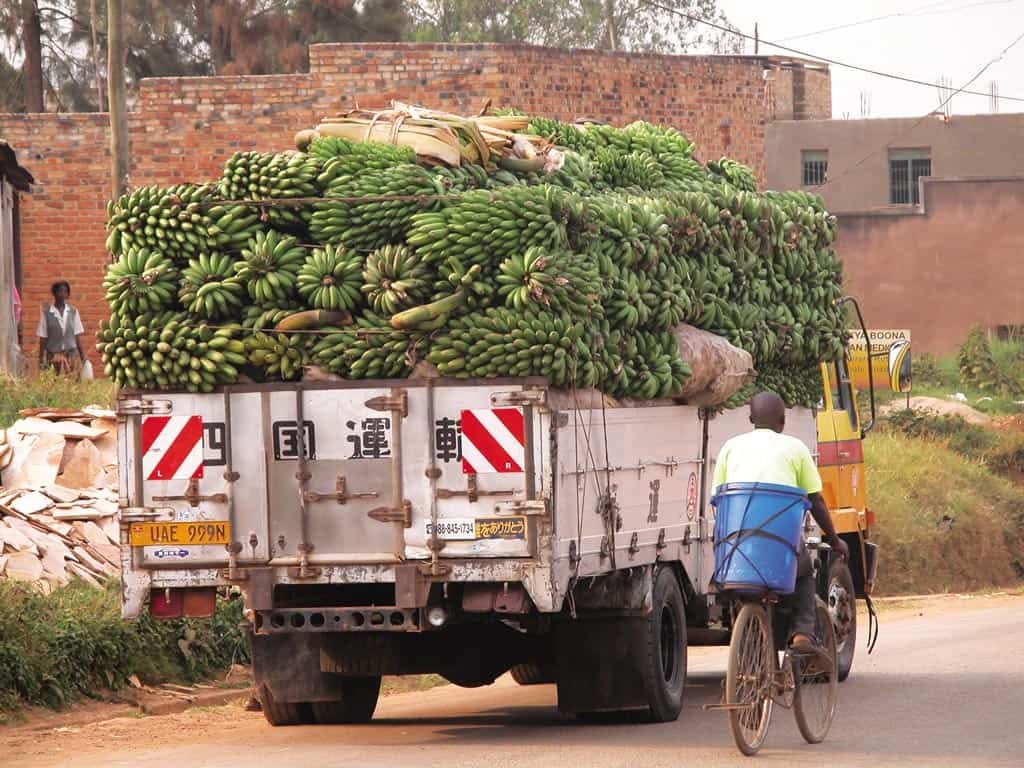Yesterday, on New Year's Eve, a post about an abundant harvest in the past tense. Today, on New Year's Day, the sequel: about harvest in the future.
THE IMAGE of two trigrams: below Heaven, above Fire. The sun is high in the sky. The dry warmth of late summer allows fruits and seeds to ripen. Thicker, heavier and sweeter they become. If you take your time, and look through your eyelids, you can see their past appearance. The still green fruit, a thickened fruit base, an open flower, pistil and stamens. And also: insects and wind, the sun and spring rain, delicate transparent leaves, the still closed leaf and flower buds. Bare frozen nature in winter. Diseases, gnawing and ever adapting to each other. Everything that is has history, has countless predecessors, hidden reasons and necessity. To make it possible to harvest the one, everything else is indispensable.
The best-selling item in the supermarket is the banana. The Cavendish banana. To meet global demand, it is propagated on an improbably large scale. Albeit only in quantitative terms: 50 billion tonnes of Cavendish bananas are grown, shipped and sold every year. However, there is no propagation in properties, taste and appearance. All these - 50,000,000,000 tonnes x 1,000 kg x 5 bananas in a kilo = 250,000,000,000,000 - Cavendish bananas per year are genetically identical. In terms of numbers: a great harvest. In terms of diversity: all those infinite bananas are clones of each other. The Cavendish no longer has the ability to evolve and adapt to changing conditions and diseases, such as the dreaded TR4 fungus.
All the more reason to protect and preserve the diversity of botanical banana varieties - and thus genetic diversity and potential resilience. It is estimated that there are more than a thousand varieties worldwide.
The world's largest collection of banana diversity isn't in one of the regions where most bananas grow - in South East Asia, Africa or Latin America. It's in Belgium. The University of Leuven is home of the International Musa Germplasm Collection ('Musa' being the genus the banana belongs to). This is a living treasury of more than 1,500 types of banana with a bewildering array of sizes, colours and flavours. The Blue Java from Indonesia has a soft, unctuous texture and tastes of vanilla ice cream, while the Ele Ele banana, one of the plants introduced to Hawaii by South Pacific settlers, is picked green and cooked as a vegetable. Some types of banana taste like strawberries or apples; some have fuzzy skins; and one Chinese banana is so aromatic it's been given the name Go San Heong, meaning 'you can smell it from the next mountain. Yet despite all its diversity, the banana is the fruit example par excellence of crop monoculture (crops of single variety).
Eating to Extinction - Dan Saladino
The threats to a great bountiful harvest are many: conflict, climate change, monoculture, monopolies in and globalisation of seed trade and more. What is true for the apple and banana is equally true for wheat and rice, potatoes and coal. Action is needed to ensure the species diversity of our food crops. By protecting the original habitat of the primal forms of crops. By listing and nurturing the countless local varieties in gardens and in small fields and orchards. And by collecting seeds and storing them safely.
Just as in earlier days all available written wisdom and knowledge was collected and collated in the Great Library of Alexandria, it was now high time to establish a great global seeds library.
On the rugged open plain of the Svalbard, in the far north of Norway, inhospitable polar landscape, stands a strange lonely door portal. It is the entrance to the Svalbard Gobal Seed Vault. Hidden deep in the permafrost - seismologically stable, far away from metropolitan hustle and bustle and political and economic hotspots - lies a giant cold storage and freezer. It was opened in 2008 after a long preliminary process and currently houses seeds of 1.2 million varieties of food crops.



There are 200,000 varieties of rice (whaaaat! I thought you could choose between white rice and fried rice, and that was it!) 4,500 varieties of potatoes (really? I knew one floury and one firm, one for fries and one for chips, then you've had it), 3,000 varieties of coconut, 35,000 varieties of maize, and a whopping 125,000 varieties of wheat!
… Just some of them are being used in agriculture. Sometimes, globally just one species remains being used, as is the case with bananas. When a disease strikes, all plants will be vulnerable, as they share the same immune system, with the risk of extinction. The vault is therefore not only providing a backup population, but also provides substitutes with different immune systems or other characteristics, enabling us to react on food supply threatening events. Alternative seeds might have the traits that we need in the future to adapt our food production to a changed environment, temperature or soil.


And finally, this. The previous chapter 13 is entitled Like-minded. Does that denote people with the same interests and preferences, wearing the same club colours, voting for the same party, or believing in the same conspiracy theory, or firmly believing in progress and technology, a group of people all in the same bubble? I don't think that is what is meant here by Like-minded.
Equals denotes all of humanity, and very specifically the ability to trust each other and work together. Everything you see around you right now is the result of building on each other's experiences - sharing inventions and, above all, learning from the mistakes. We stand on each other's shoulders. Generation after generation passes the baton to each other, mostly without being aware of it. Similarity is the deepest characteristic of human beings: cumulative culture.
Without cumulative culture, there would not have been 200,000 varieties of rice and 125,000 varieties of wheat. No bewildering diversity of apples and bananas. Sure, the impending demise of that wealth is an error, a collective error. But man never backs down. A Great Harvest was the result of Like-minded. So are projects like the Svalbard Global Seed Vault.
to be continued ...









What you can do : Support small farmers who sell heirloom fruits and vegetables at local growers markets!